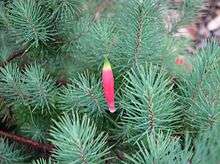Stenanthera
Stenanthera is a genus of flowering plants in the family Ericaceae. Most are low shrubs with leaves that are paler on the lower surface, tube-shaped flowers and with the fruit a drupe. There are three species, formerly included in the genus Astroloma.
| Stenanthera | |
|---|---|
 | |
| Stenanthera pinifolia in Maranoa Gardens | |
| Scientific classification | |
| Kingdom: | Plantae |
| Clade: | Tracheophytes |
| Clade: | Angiosperms |
| Clade: | Eudicots |
| Clade: | Asterids |
| Order: | Ericales |
| Family: | Ericaceae |
| Genus: | Stenanthera R.Br[1] |
| Type species | |
| Stenanthera pinifolia | |
| Synonyms[1] | |
Description
Plants in the genus Stenanthera are mainly low shrubs with leaves that are paler on the lower surface where the veins are almost parallel to palmate. The flowers are borne in leaf axils and have both male and female organs. There are bracts and bracteoles and the base of the flower and the petals are joined to form a more or less cylindrical tube. The petal lobes are triangular to egg-shaped and erect or turned backwards, usually with hairs on the inner side. The anthers protrude from the petal tube but are hidden by the petal lobes. The style is thread-like and equal in length to, or longer than the petal tube. The fruit is a drupe with a hard endocarp.[2]
Taxonomy and naming
The genus Stenanthera was first formally described in 1810 by Robert Brown in Prodromus Florae Novae Hollandiae et Insulae Van Diemen. The type species is S. pinifolia.[3][4] In 1868, George Bentham transferred the genus to Astroloma as Astroloma sect. Stenanthera in Flora Australiensis[5][6] but following genetic studies in 2013, the genus Stenanthera was resurrected.[2][7] The name of the genus comes from ancient Greek words meaning "narrow" and "flower".[8]
Species list
The following species names are accepted by the Australian Plant Census as at January 2020:
- Stenanthera conostephioides Sonder (flame heath) - South Australia, Victoria[9]
- Stenanthera pinifolia R.Br (pine heath) – New South Wales, Victoria, Tasmania[10]
- Stenanthera pungens (Keighery) Hislop – Western Australia[11]
Distribution
Stenanthera species are found south-western Western Australia[12][13] and in south-eastern Australia.[14][15]
Use in horticulture
Stenantheras are difficult to grow and maintain in a garden but S. pinifolia can be propagated from cuttings and grown in well-drained soil in a semi-shaded position.[7]
References
- "Stenanthera". Australian Plant Census. Retrieved 15 January 2020.
- Messina, Andre. "Stenanthera". Royal Botanic Gardens, Victoria. Retrieved 18 March 2020.
- "Stenanthera". APNI. Retrieved 18 March 2020.
- Brown, Robert (1810). Prodromus florae Novae Hollandiae et insulae Van-Diemen, exhibens characteres plantarum quas annis 1802-1805. London: R. Taylor et socii. p. 538. Retrieved 18 March 2020.
- "Astroloma sect. Stenanthera". APNI. Retrieved 18 March 2020.
- Bentham, George; von Mueller, Ferdinand (1868). Flora Australiensis (Volume 4). London: Lovell Reeve & Co. pp. 152, 158. Retrieved 18 March 2020.
- "Stenanthera pinifolia". Australian Native Plants Society (Australia). Retrieved 18 March 2020.
- Francis Aubie Sharr (2019). Western Australian Plant Names and their Meanings. Kardinya, Western Australia: Four Gables Press. p. 115. ISBN 9780958034180.
- "Stenanthera conostephioides". Australian Plant Census. Retrieved 15 January 2020.
- "Stenanthera pinifolia". Australian Plant Census. Retrieved 15 January 2020.
- "Stenanthera pungens". Australian Plant Census. Retrieved 15 January 2020.
- "Brachyloma geissoloma (F.Muell.) Cranfield". Atlas of Living Australia. Retrieved 13 January 2015.
- "Astroloma R.Br.Cranberry Heath". Atlas of Living Australia. Retrieved 13 January 2015.
- "Astroloma conostephioides". Electronic Flora of South Australia. Retrieved 13 January 2015.
- Powell, J.M. (1992). "New South Wales Flora online". National Herbarium of NSW. Retrieved 13 January 2015.